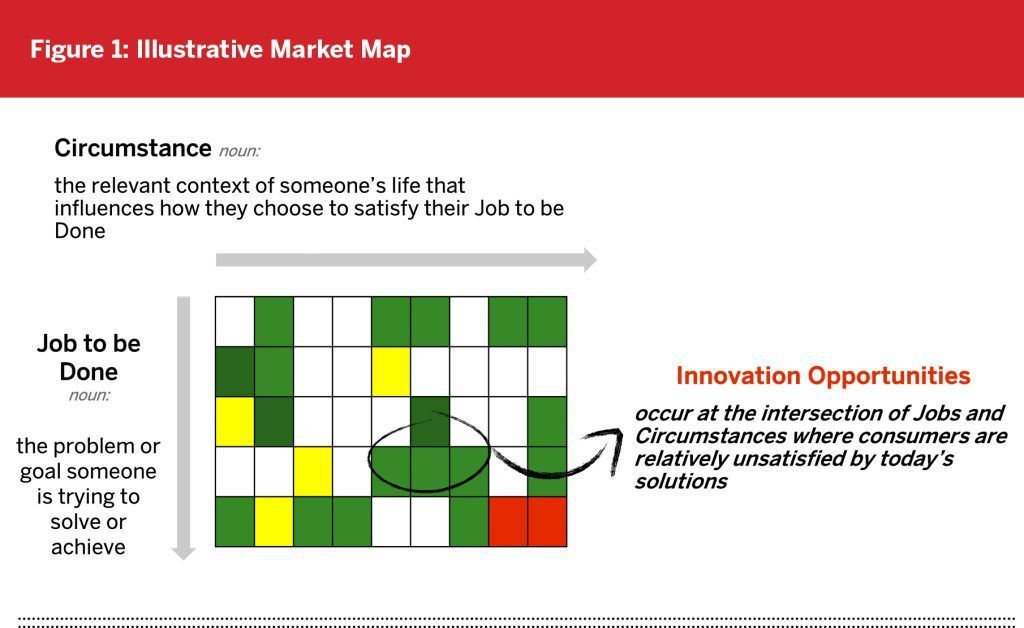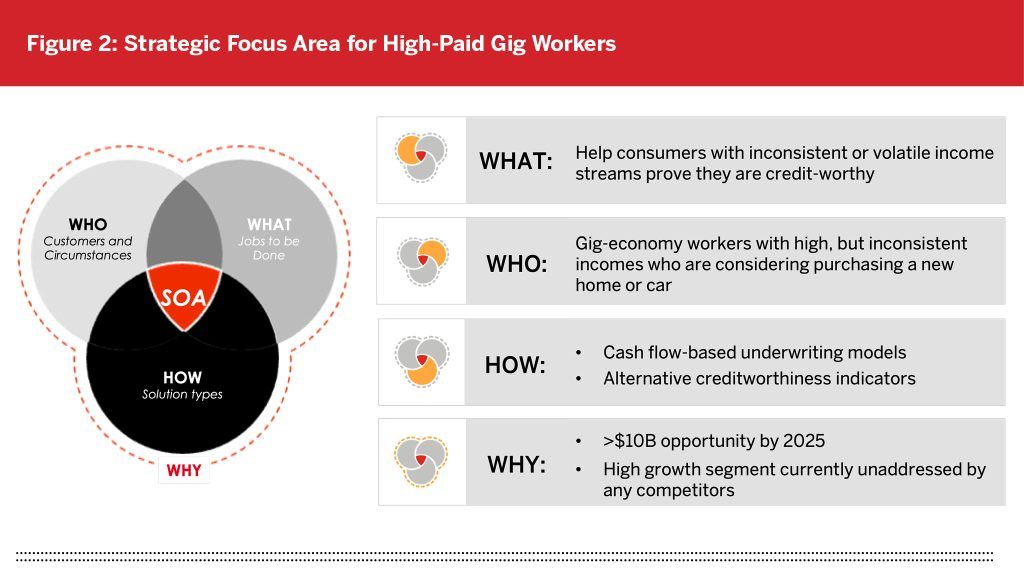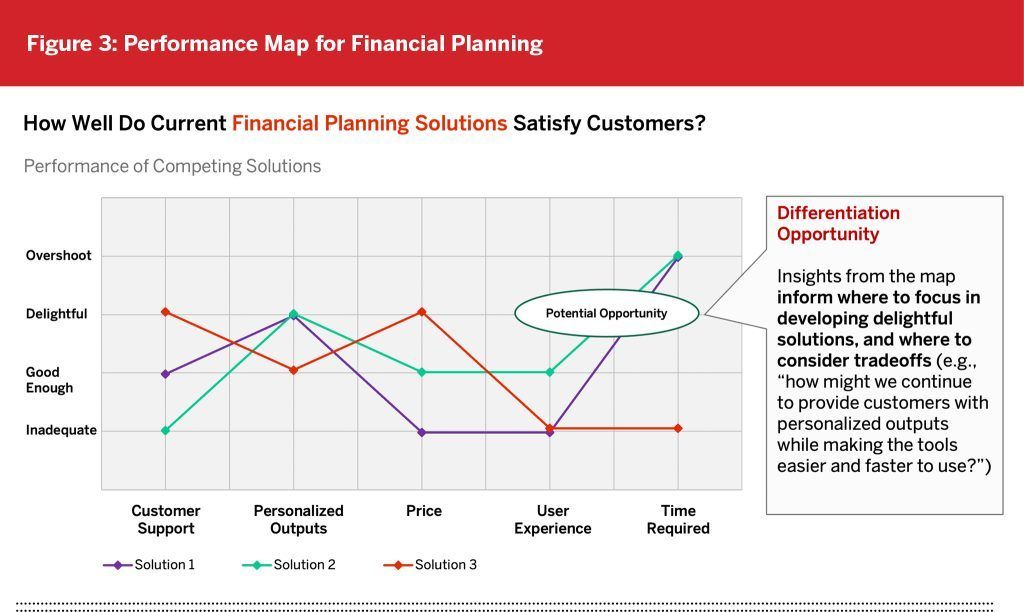Technology and Customer-Centric Vision in Financial Services
Innosight's POV: to achieve sustained growth, incumbents must do more than push old products through new digital channels. They must create truly customer-driven innovations that are centered on new value propositions.

In the previous articles, we have highlighted the impacts of enabling technologies and related operative models in the financial services industry (e.g., advanced analytics, and AI). But how to build a holistic vision? Financial services incumbents are under pressure to meet the fintech challenge by delivering more innovation faster. As companies like the payment provider Stripe and NuBank, a consumer banking services company, have shown, disruptive startups can scale quickly and become major competitors to established players. Some tools used for example by Innosight can hugely support the effort.
The challenge for incumbents is how to compete against insurgent new entrants. Financial services is a mature industry with well-established business models and many entrenched advantages for its incumbents, including established customer bases, customer stickiness, and well-recognized brands. Many players can stave off disruption for a time with “fast follow” strategies, quickly reproducing the novel products and services the fintechs pioneered, and leveraging their established distribution channels to drive volume and adoption.
The approach is not foolproof, however. Startups Venmo and Cash App have sustained their market position despite the introduction of Zelle, a solution backed by some of the largest banks in the world. To achieve sustained growth, incumbents must do more than push old products through new digital channels. They must create truly customer-driven innovations that are centered on new value propositions.
In our work with clients, we have identified three common barriers to innovation success. Fortunately, there are powerful tools that can be used to overcome them.
Barrier 1: A Lack of Clarity on Who the Customer is and What Need is Being Addressed
Many organizations tailor their innovation efforts to a small set of high-level personas that match the socio-economic and demographic attributes of target customers. They might even give those personas names, to make them recognizable and relatable. But too often, they are overly broadly defined and “averaged out,” resulting in products that struggle to appeal to or create value for any real customers.
Recommended Tool: Market Maps
In our view, successful innovation begins with a deep understanding of a customer's job to be done, meaning a problem or goal that customers are trying to solve or achieve in a particular circumstance. A broadly held job in financial services might be “buy a home for my growing family,” or “make sure I don’t spend beyond my means.” Using a customer jobs framework provides insights at a level of granularity that standard personas can’t match. But while jobs to be done are permanent, their relevance varies across individuals depending on their specific circumstances, and on the solutions that are available to them in the market.
A tool called Market Maps can help executives visualize this problem space. It's designed by Innosight.
Market Maps are created by laying out customer circumstances on one axis and jobs to be done on the other. Each resulting cell on the matrix can then be evaluated to see if an innovation opportunity arises for that combination of job to be done and circumstance. We ask three questions when we are evaluating them:
- Is the job to be done prevalent? Do a lot of customers have this job to be done in their circumstances?
- Is the job to be done unsatisfied? Do existing solutions in the market have significant shortcomings?
- Is the job to be done high value? Would customers pay to have this job solved?
If the answer to all three questions is “yes,” then the innovation opportunity is likely worth exploring.

Barrier 2: Spreading Investment Dollars too Thinly to Have a True Impact
When innovation efforts are not clearly directed, and when teams across the organization are not aligned on a small number of priorities, money, people, and management attention can be too diffused to make much difference. This challenge of alignment and focus is particularly acute in agile organizations, where priority-setting and decision-making is widely distributed.
Furthermore, organizations can struggle to see the benefits they receive from their investments in innovation, especially when they come in the form of “customer experience” improvements, which are difficult to quantify and attribute directly to financial performance.
Recommended Tool: Strategic Focus Areas
Strategic Focus Areas help codify opportunities by defining the customer, their job to be done, and the kinds of solutions that can be developed to address it. Each Strategic Focus Area acts as a hunting ground for innovation, delineating the general area that teams should explore, but also leaving room for them to test and learn their way to solutions.
SFAs can be evaluated across two dimensions to determine the quality of fit for an organization and its priority. Those dimensions are:
- Attractiveness—for example, addressable market, potential customer base, margin potential in the category—;
- Feasibility, meaning how well it fits the organization’s capabilities and aligns with its strategy.
To drive focus, organizations should focus on a small number of Strategic Focus Areas, perhaps as few as three to five. This also ensures that sufficient resources can be invested to drive growth once a concept is sufficiently proven.
Alasdair Trotter, "We advised a consumer banking organization that was weighing the idea of creating products or services tailored to the specific needs of gig workers. Using a Market Map, we identified key combinations of jobs to be done and customer circumstances for that segment of workers. One revelation was that freelance accountants and other highly compensated professionals have the job to be done of “access credit for a major purchase,” which can be difficult due to their irregular incomes. Armed with this insight, we defined an SFA around alternative loan products and underwriting services."

Barrier 3: Bringing Undifferentiated Solutions to the Market
When developing new products, many organizations rightly focus on the user experience, product design, and pricing. However, they often forget to ask a crucial question: “How are we going to solve this problem better than any other company?” and thus miss the opportunity to create differentiation.
The lack of a clear point of view, backed up by evidence, of why a customer should choose one company’s product over another’s often leads to promising products that nonetheless fizzle when they are introduced.
Recommended Tool: Performance Maps
A Performance Map can help executives visualize the performance of competitors’ products from their customers’ perspectives. To evaluate them, they must consider which features customers value – this often includes price, convenience, ease of use, and other factors – and then chart them against each other and against the customers’ definition of quality.
"One of our clients, a wealth management firm, was seeking to create new products that would appeal to younger investors. After evaluating several financial planning tools from leading competitors, we found that a trade-off was embedded in all of their designs. On the one hand, they were very sophisticated, outputting highly personalized projections and providing customized advice. However, they were also very complex to use, requiring a high degree of engagement with the subject, as well as a good deal of time to gather information. Our analysis suggested that these tools were likely “overshooting” the needs of beginner investors, who might appreciate a less sophisticated but easier to use product."

Many of our clients have sophisticated approaches to innovation, from agile principles to a commitment to testing and learning. But unless these three barriers are overcome, companies can waste time and money developing new products that don’t actually address their customers’ needs, or that are insufficiently different from what already exists in the market to attract new customers. Or, they can create a perfectly sound product but fail to support it enough to allow it to break through in an extremely competitive marketplace.
By utilizing Market Maps, Strategic Focus Areas, and Performance Maps to generate high-quality hypotheses at the beginning of the innovation process, organizations can avoid those and other pitfalls.
***
Alessio De Filippis, Founder and Chief Executive Officer @ Libentium.
Founder and Partner of Libentium, developing projects mainly focused on Marketing and Sales innovations for different types of organizations (Multinationals, SMEs, startups).
Cross-industry experience: Media, TLC, Oil & Gas, Leisure & Travel, Biotech, ICT.











